Students suffering from disability of any kind find it hard to manage everything in class and attend lectures on a daily basis. These students have trouble keeping up with everything that is taught in school. They are also unable to work at the same level as their classmates who do not have any developmental or physical impairments. They need extra assistance to perform well academically. In today’s digital age, assistive technology has become one of the best forms of assistance for people with disabilities.
Assistive Technology Act:
Assistive technology or what we commonly know as AT, was not only recognized as a necessity across the United States, but it was also written into the law when Assistive Technology Act was passed in 1998. Former President Bill Clinton was behind the revision of the Rehabilitation Act of 1973 which required the Federal agencies to make their electronic and information technology easily accessible to individuals with disabilities.
According to law, Assistive Technology is “any item, piece of equipment, or product system, whether acquired commercially off the shelf, modified, or customized, that is used to increase, maintain, or improve functional capabilities of individuals with disabilities.”
Under Section 508 of the law, agencies should provide employees with disabilities and public citizens with access to information similar to that which is available to others.
Assistive technology has broken down the various barriers that hindered and created difficulties for disabled students to perform to their full academic potential. The AT has significantly contributed to the cause of studying in an inclusive classroom instead of a segregated one.
How assistive technology has helped students with special needs
The main challenge students with disabilities have to deal with accurate identification of the disabilities before moving towards conventional teaching settings.
AT addresses a variety of learning complications. Students suffering from cognitive, physical, psychological, and learning deficiencies on various levels can benefit from assistive technology. For example, a student who has trouble writing could use special software and compose a school report by dictating it and getting it converted to text. A teen with dyslexia could use AT which would read aloud text for him. Or a child who has difficulty with math could take help from a hand-held calculator to keep score while playing games.

There are special AT tools and gadgets that assist disabled people with:
Reading: There are numerous tools that help people who struggle with reading. All of these tools might vary from each other a little bit but, all of them help the reader by converting the text as speech. Few types of AT reading tools are text-to-speech (TTS), audiobooks, digital TTS books, and graphic organizers. These tools help the reader with decoding, reading, comprehension, and fluency. Nowadays, mobile devices and tablets come with in-built AT.
Writing: Like reading, there is quite a range of assistive technology available for those who struggle with the task of writing. For those who have issues with holding a pencil/pen, can benefit from handwriting tools that help with the task of writing. Some other forms of writing AT tools are touchscreens and keyboards, word prediction, dictation (speech-to-text), grammar check, and spell check.
Like reading, there is a built-in AT for writing on mobile devices. Also, you can add chrome apps and extensions in Chrome browsers or use Chromebooks.
Listening: Those people who have issues in processing and remembering the spoken word suffer from auditory processing disorder. Listening devices can be integrated into a class or a meeting having multiple speakers. Some examples of listening to tools are noise-canceling headphones, audio recorders, and personal listening devices (PLD) sound field systems.
Math: There are special tools for those which help people who struggle with calculating, computing, aligning and copying down math problems on paper. With the help of AT tools such as visual and audio support, users can solve basic math problems more easily and efficiently.
Memory & Organization: Using AT tools allows a person with disabilities plan, organize and keep a track of things such as task list, contacts, and other notes. These tools help them in managing, storing, and recovering that information while using specific hand-held devices and software.
Tracking and Monitoring: Technology has not only helped students but parents as well. Parents or guardians with speaking difficulties or those who have trouble in mobility can make use of monitoring apps and software which they can install on their children’s phones. For example, a child monitoring app can help parents with disabilities keep an eye on their children remotely. The app lets them monitor their real-life and digital activities along with their web browsing history, locations, text messages, call logs and a lot more while sitting in the comfort of their home.
The Impact of Assistive Technology:
Dr. Richard Nyankori, who works as a deputy chancellor for special education at District of Columbia Public schools says that with the help of assistive technology, students now have access to educational opportunities across America. AT shatters the barriers in the way of academic success and opportunities in the future. According to an article on the DCPS website in 2011, students reported that AT tools and devices made a huge difference in their academic performance.
Apart from education, AT also helps students in developing their social skills as well which tends to get negatively impacted due to their impairments. Usually, students find it difficult to connect with their classmates that makes it difficult to make friends. AT devices helps them in engaging with others so that they do not feel isolated.
Empowering students with AT tools that assist them with speech, mobility, calculation, and understanding prepares a path of a brighter future for them. AT has the power to change the lives of people with special needs if integrated into classrooms and routine life from an early age.
Written by Dr. Richard Nyankori



